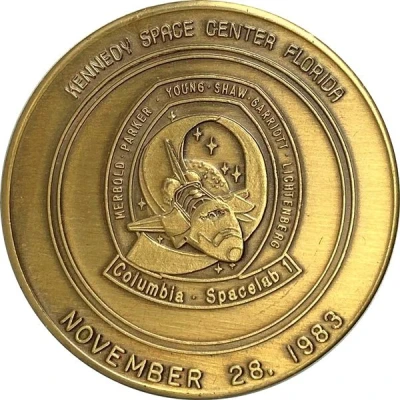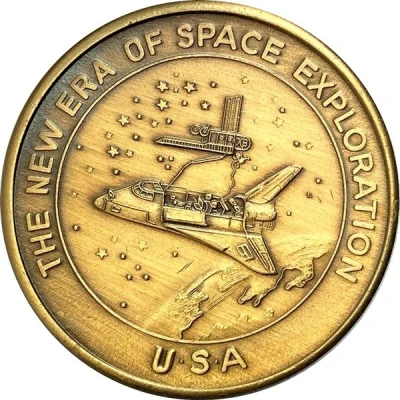


The New Era of Space Exploration (STS-95 Discovery) ND
| Silver (.999) | 31.2 g | 39.3 mm |
| Location | United States |
|---|---|
| Type | Medals › Souvenir medallions |
| Composition | Silver (.999) |
| Weight | 31.2 g |
| Diameter | 39.3 mm |
| Thickness | 2.85 mm |
| Shape | Round |
| Technique | Milled |
| Orientation | Medal alignment ↑↑ |
| Updated | 2024-11-13 |
| Numista | N#432289 |
|---|---|
| Rarity index | 97% |
Reverse
The STS-95 mission insignia was designed by the crew, and evokes the scientific, engineering and historic elements of the flight. It depicts a stylized blue Space Shuttle with yellow, red, and blue streamers coming from its stern that represent the global benefits of the mission's science experiments and the solar science objectives of the Spartan satellite. A small Mercury space capsule is depicted orbiting the Shuttle, and the red streamer extends up towards the center of the Shuttle to form a "7". The capsule and the number seven are in reference to Glenn's historic association with the Mercury Seven astronauts and their spacecraft: all of the crewed Mercury spacecraft had "7" as part of their name. The mission payloads—microgravity material science, medical research for humans on Earth and in space, and astronomy—represent three major scientific fields and are symbolized in the insignia by rocket plumes.
Script: Latin
Lettering:
KENNEDY SPACE CENTER FLORIDA
DUQUE BROWN LINDSEY ROBINSON
DISCOVERY
MUKAI GLENN PARAZYNSKI
OCTOBER 29, 1998
Unabridged legend: STS = Space Transportation System
Edge
Plain with inscription
Script: Latin
Lettering: .999 FINE SILVER
Comment
STS-95 was a Space Shuttle mission launched from Kennedy Space Center, Florida on 29 October 1998, using the orbiter Discovery. It was the 25th flight of Discovery and the 92nd mission flown since the start of the Space Shuttle program in April 1981. It was a highly publicized mission due to former Project Mercury astronaut and United States Senator John H. Glenn Jr.'s return to space for his second space flight. At age 77, Glenn became the oldest person to go into space, a record that remained unbroken for 23 years until 82-year-old Wally Funk flew on a suborbital flight on Blue Origin NS-16, launching on 20 July 2021, which in turn was broken by William Shatner at age 90 on 13 October 2021 and then by Ed Dwight on May 19 2024. Glenn, however, remains the oldest person to reach Earth orbit. This mission is also noted for inaugurating ATSC HDTV broadcasting in the U.S., with live coast-to-coast coverage of the launch. In another first, Pedro Duque became the first Spaniard in space.
The mission's objectives involved investigating life-sciences experiments, using the SpaceHab module to perform these experiments on Senator Glenn. Scientific objectives on this mission were not limited to furthering an understanding of the human body, but also to increase astronomical understanding with regards to the Sun, and how it affects life on Earth. The Spartan 201 spacecraft was released by the crew, flying free from the Shuttle, studying the acceleration of the solar wind that originates in the Sun's solar corona. The mission lasted just under ten days, with Discovery completing its voyage by landing at the Kennedy Space Center's Shuttle Landing Facility.
The launch was rare in that the official launch weather forecast provided by the 45th Weather Squadron was 100 percent for favorable weather for launch as well as the Shuttle Landing Facility.



